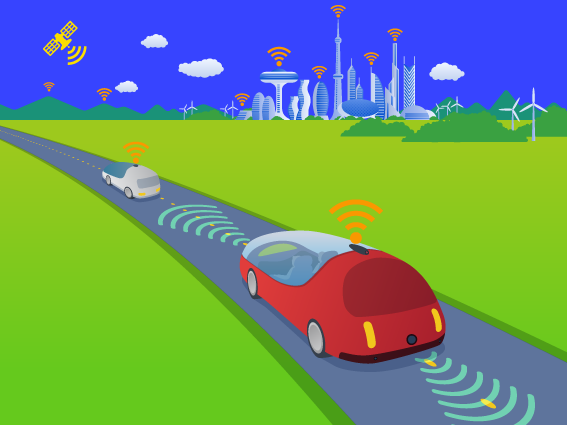The Story Behind Smart Roadways May Surprise You
Need is the best driver of amazing innovations. The planet’s environment struggles with its resource limits. The need to be sustainable grows. Cities grow in size building the need for smart transportation. At the intersection of sustainable and urban growth, amazing innovations reshape the way we

Need is the best driver of amazing innovations.
The planet’s environment struggles with its resource limits. The need to be sustainable grows. Cities grow in size building the need for smart transportation. At the intersection of sustainable and urban growth, amazing innovations reshape the way we get around and how we care for our planet.
With Elon Musk's vision for rebooting the once-failed electric car idea, Tesla Motors has started a trend. Today, over half a million electric cars travel the roadways in the United States. Tesla’s goal is to increase that number to one million by 2020. (See Musk’s amazing innovations tips).
The FlyKly Smart Wheel is another amazing transportation innovation. This Smart Wheel converts bikes into electrically powered vehicles. Making a bicycle easier to power broadens its use for city commuters. This brings us one step closer to alleviating congestion in crowded cities.
As fascinating as these are, electric vehicles, smart powered bicycles and self-driving cars alone won't solve environmental and traffic problems. For a truly smart solution, we need to integrate these technologies into a comprehensive network.
Smart Roadways
What fuses these innovative ideas together is smart, powered roadways. This technology promises to change the way future cities work. Smart roadways will act as a continuous modular power and information grid.
No More On-Site Construction
“Modular” means the system comes in small units that link together. These building blocks are designed for efficient replacement. When one unit fails, the smart grid sends a request to the city for maintenance. A dispatched vehicle will respond with a new unit and replace the damaged one. Broken units will be refurbished at a specialized facility. Road repairs will happen away from the roads and will not impede traffic flow.
Convenient Access to Power
The modular road will simplify infrastructure maintenance replacing above-ground and underground power and fiber-optic lines. The road itself will also benefit from the information and power flowing through it.
Today, electric cars need to charge at a charging station for hours. It's not convenient and having a car is all about convenience.
Smart roadways promise to solve this problem by charging cars wirelessly as they drive down the road. This improves the convenience of electric cars and reduces the need for long-lasting car batteries.
Reducing Traffic Chaos
Smart roads can “repaint” themselves based on traffic information to reduce congestion. They can detect and provide valuable information about traffic, pedestrians, and other objects on roads. They can display warnings in response to real-time information about accidents and emergency vehicles. When self-driving cars are in circulation, the grid can route and optimize traffic flow.
Heat and Solar Power
Smart roads can use their power to heat the road surface and melt falling snow. Sidewalks can benefit from the same feature – no shoveling, no snow plows.
Potentially smart roads can power themselves and their cities with integrated solar panels.
The result is a multi-use infrastructure with a huge scope of functions. It's a great example of innovation, but its simple origin may surprise you.
The Story Behind Smart Roadways
The whole concept of smart roadways started with a narrower concept: solar panels you can drive on.
Scott and Julie Bursaw, a married couple in Sandpoint, Ohio, started with that idea. Julie imagined roads constructed with solar panels. Scott, an engineer, initially dismissed the idea as impossible: solar panels are fragile. However, his “engineering mind just couldn't let it go.” He realized it could be possible and felt he had the expertise to make their dream a reality. They started their company, Solar Roadways, in 2006 to launch their innovation concept.
In 2009, the couple received their first round of funding: $100,000. This was a Small Business Innovation Research (SBIR) grant from the United States Department of Transportation (USDOT). After proving the feasibility of their technology, USDOT granted them another SBIR grant in 2011 worth $750,000 to develop a solar parking lot.
With significant research, development, and a number of awards, the couple gained attention. Their simple concept to build roads out of solar panels had evolved into the broader concept of a smart roadway system. Solar power was now one of many important features.
In 2014, a passionate follower of the idea created a viral video that would change the course of their project. The video has over 22,000,000 views and has powered their IndieGogo campaign raising more than $2 million.
With the sudden exposure came negative publicity. Like Scott’s initial response, some important scientists rejected the idea of solar powered roadways as implausible. Among the criticisms was that the technology was unduly expensive.
Undeterred, Scott and Julie addressed each technical challenge as it arose. USDOT issued Solar Roadways a third grant worth $750,000 in 2015 to continue the research. Solar Roadways continues to develop this amazing innovation through that grant.
Going From Solar to Smart
The technology that Scott and Julie have developed is increasingly relevant as the demand for smart infrastructure grows. While solar power remains a central part of their idea, it’s evolved into something greater: a smart infrastructure that addresses both urban congestion and sustainability.
With their first idea of solar powered roads, the couple probably had little concept of where it would take them. They were passionate, believed in their idea, and pursued it in small, measured steps. Recognizing the significant applications of this technology,the USDOT funded the project and continues to do so.
If you have an innovative idea that you're passionate about, consider joining The Innovators Community. This community is passionate about accelerating innovation and its members would love to talk to you about your ideas!
Phil McKinney Newsletter
Join the newsletter to receive the latest updates in your inbox.




